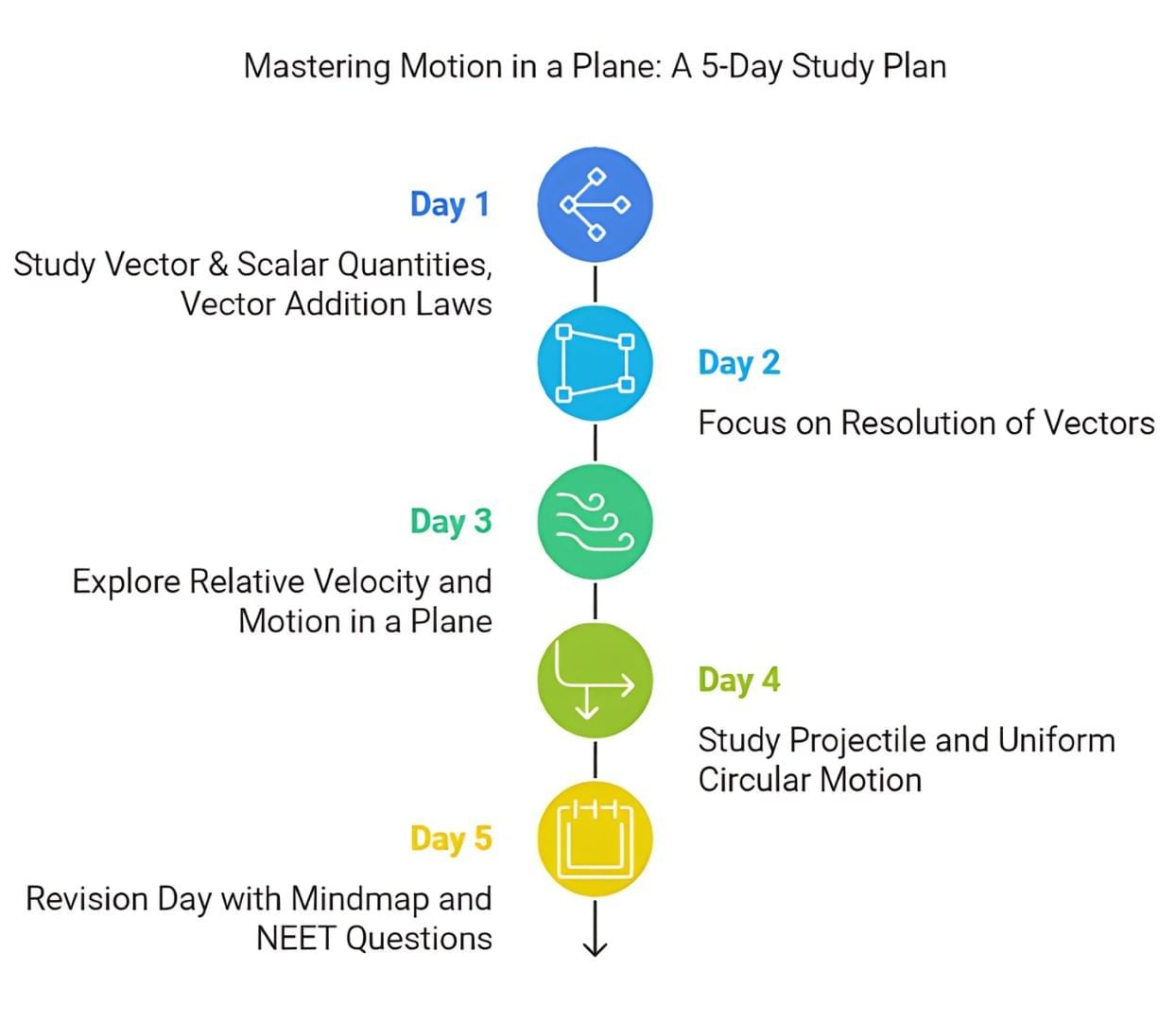5 Days Study Plan: Motion in a Plane | Physics Class 11 - NEET PDF Download
Let's explore the Class 11 Physics chapter called "Motion in a Plane" and understand how it's important for the NEET exam. By studying the past years NEET questions (from 2016 to 2025), we can see that this chapter is crucial in the exam. If you want to score well in NEET, you need to grasp the concepts in this chapter.
Introduction
The chapter "Motion in a Plane" in Class 11 Physics covers various essential topics:
- Vector & Scalar Quantities
- Addition & Subtraction of Vectors (Triangular & Parallelogram Laws) - Graphical Method
- Resolution of Vectors: Motion in a Plane
- Relative Velocity in Two Dimensions
- Introduction to Motion in a Plane
- Projectile Motion
- Uniform Circular Motion

Day 1: Vector & Scalar Quantities, Addition & Subtraction of Vectors (Triangular & Parallelogram Laws) - Graphical Method
Divide your day into two parts. In the first half, study Vector & Scalar Quantities and the second half, focus on triangle and parallelogram laws of vector addition. Refer to the NCERT textbook for these topics.
- Learn about vector addition and subtraction, including the Triangular & Parallelogram Laws.
- Practice related questions from EduRev's Sources.
Day 2: Resolution of Vectors
On the second day of topic study, focus on the Resolution of Vectors.
Practice questions related to this topic:
- Attempt questions from your NCERT textbook.
- Utilize EduRev's resources for more practice.
- Go through the cheat sheet doc of vectors for better clarity.
Day 3: Relative Velocity in Two Dimensions, Introduction to Motion in a Plane
Dedicate one day to Relative Velocity in Two Dimensions and on Introduction to Motion in a Plane, as described in the NCERT textbook.
For Relative Velocity:
- Study the concept of relative velocity in two dimensions.
- Work through problems in your NCERT textbook.
- Practice additional questions from EduRev's resources.
For Introduction to Motion in a Plane:
- Understand the basics of motion in two dimensions as per the NCERT textbook.
- Attempt questions from EduRev's Quick Revision section.
Day 4: Projectile Motion, Uniform Circular Motion
Start by reading the relevant section in your NCERT textbook. Pay close attention to the equations and principles of projectile motion. Afterward, practice the following on EduRev:
- Attempt questions from the NCERT Solutions.
- Solve questions from the Short & Long Answer Question section.
- Use the Mindmap for a visual summary of the concepts.
For Uniform Circular Motion:
- Understand the principles of uniform circular motion.
- Solve problems from your NCERT textbook.
- Use EduRev's resources to attempt more questions.
Day 5: Revision Day
Today is dedicated solely to revision. Here's how to revise effectively:
- Summarize key concepts from each topic.
- Review important formulas and principles.
- Solve a mix of short and long questions.
- Revisit the Mindmap for a quick overview.
- Take a final look at past years NEET questions for this chapter (2016-2025).
Remember, EduRev provides NCERT-based notes and solutions to NCERT questions, making it a valuable resource for your preparation. Use the provided links to access these resources and maximize your understanding of the chapter "Motion in a Plane."
By following this structured study plan, you'll be well-prepared to tackle the NEET exam confidently.
Here are all the important links and topic-specific links for the chapter "Motion in a Plane" at the end for your convenience:
Important Links:
Topic Links:
- Vector & Scalar Quantities
- Addition & Subtraction of Vectors (Triangular & Parallelogram Laws) - Graphical Method
- Resolution of Vectors: Motion in a Plane
- Relative Velocity in Two Dimensions
- Introduction to Motion in a Plane
- Projectile Motion
- Uniform Circular Motion
By clicking on these links, you can access the respective resources for each topic and prepare thoroughly for the chapter "Motion in a Plane" in your Class 11 Physics.
Good luck with your studies and your NEET exam preparation!
|
96 videos|367 docs|98 tests
|
FAQs on 5 Days Study Plan: Motion in a Plane - Physics Class 11 - NEET
| 1. What are the differences between vector and scalar quantities? |  |
| 2. How do you add vectors using the triangular law? |  |
| 3. What is the concept of relative velocity in two dimensions? |  |
| 4. What are the key characteristics of projectile motion? |  |
| 5. How can uniform circular motion be described? |  |

















